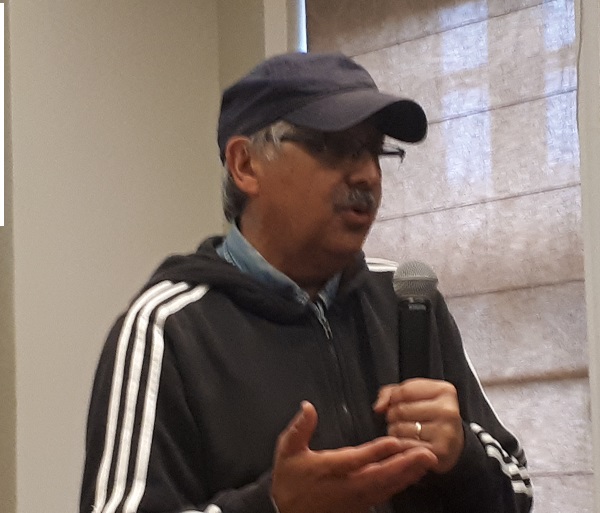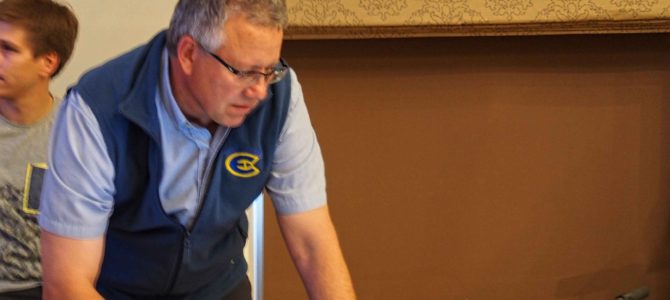by Geoff Vasil
What hast thou done? The voice of thy brother’s blood crieth unto me from the ground.
The Lithuanian Jewish Community hosted a presentation of Dr. Richard Freund’s book “The Archeology of the Holocaust. Vilna, Rhodes and Escape Tunnels” Tuesday evening with slide-show presentations by Harry Jol, Philip Reeder, Paul Bauman and Alastair Clymont as well as Freund. This group of archaeologists has been working on the Great Synagogue site in Vilnius for several years now, as well as Holocaust sites in Lithuania including their discovery of the escape tunnel of the burners’ brigade at Ponar, which became the main topic of a documentary aired by the Nova program on the PBS network in the United States.
Lithuanian Jewish Community chairwoman Faina Kukliansky greeted the audience and introduced the topic and speakers, thanking the archaeologists for their important work on Lithuanian Jewish heritage.
Marcus Micheli, deputy chief of mission at the US embassy in Vilnius, spoke next. The US diplomat also called the archaeologists’ work crucial and said it had given rise to new conservations about the painful past.
“He and his team [Freund and company] have made very important contributions to the discovery and preservation of Jewish cultural heritage in Lithuania, from the discovery of the escape tunnel in Paneriai [Ponar] to determining the site of Matilda Olkin, who was a young Jewish Lithuanian poet, where she was executed, he’s uncovered details about Lithuania’s history are initiating really important conservations, healing old wounds and bringing communities together. It’s a real service and really good work that he’s doing here,” Micheli said.
“Our embassy has supported Dr. Freund’s work since 2017. I’ll give a few examples of this. These include a survey of the Ninth Fort in Kaunas, the work excavating the Great Synagogue of Vilna, the study of burial sites in Rokiškis with ground-penetrating radar and most recently the research he and his team are doing on Rumšiškės where they are collecting video and surveying a submerged village, which is really actually quite fascinating. His work has been really critical in preserving Lithuania’s rich Jewish cultural heritage. Moreover, his discoveries have assisted Lithuanian and Jewish citizens around the world to reconnect to their past by recovering a lost history, the history of thousands of lives which were lost during the Holocaust. Dr. Freund, thank you very much for your support of the Jewish community here in Lithuania and you and your team’s contributions to the cultural legacy of Lithuania. All of us at the embassy look forward to further cooperation. We look forward also to reading and hearing more about your fascinating discoveries,” Marcus Micheli said.
Vilnius Jewish Public Library director Žilvinas Bielauskas was introduced as the moderator and invited spoke about the trouble he had taking delivery of 22 copies of Freund’s book from the post office. He then introduced Paul Bauman, the chief geophysicist of the project who lives in Calgary, Alberta, to the microphone. Bauman explained some of the non-invasive techniques used to locate the escape tunnel at Ponar and the mapping of the results. He also spoke about the Sobibor extermination camp in eastern Poland where a high-resolution metal detector and electrical resistance tomography were used to define the actual camp and subsequently to locate posts initially thought to be stilts on top of which the gas chamber there sat, but which later turned out to be part of a fence separating different parts of the camp. Dr. Bauman concluded his presentation with a quote which initially sounded like the testimony of a Holocaust survivor, but which he then attributed to a woman who survived mass murder at the hands of Islamic militants in northern Iraq.
“That’s why we do this type of work, to develop new techniques, a consistent methodology to map these sites, to understand these sites, and part of it is to send a warning that, no matter what efforts someone might take to carry out these atrocities, even decades later they can be unmasked and mapped out,” Bauman said.
“Nothing can be hidden in the earth and sooner or later it will be discovered,” moderator Bielauskas commented.
Harry Jol, a physical geographer originally from Canada and now at University of Wisconsin, then gave a concise, detailed and somewhat technical explanation of non-invasive archaeological techniques, including the use of side-scanning sonar at the underwater shtetl of Rumšiškės (Rumshishok) and comparisons with Luftwaffe aerial reconnaissance photography and using ground-penetrating radar at Market Square in Šeduva to discover the location of one of the synagogues there.
Professor Philip Reeder of Duquesne University spoke further about mapping. He presented a multi-layered map of the Great Synagogue site in Vilnius and discussed finding graves of Holocaust victims near Rokiškis (Rokishok) using German aerial photographs and non-invasive techniques. Reeder also talked about investigating a Soviet mass murder atrocity at the Pravieniškės prison in Lithuania.
Dr. Richard Freund spoke passionately for just under an hour about archaeology, Vilnius and the 2,300-year-old Jewish community on the island of Rhodes in Greece. “We have done 36 Holocaust-era sites. Normally that would be ten lifetimes for an archaeologist,” he said.
“Archaeology is the most destructive science on earth. It’s labor intensive. At one site in Israel we brought 10,000 workers, students, over the past 30 years, and we have done 2 acres. It’s destructive, it’s labor intensive, it’s expensive,” he said. “It’s pretty ineffective by itself,” he continued, “we are losing daily those people who are providing reasonable testimonies about this work. So if it looks like we are in a rush to do lots of sites, we are in a rush to do lots of sites. These people we have to really thank, because without them we would be spinning our wheels. What is really there, how do we know?”
“I am a proud Litvak Jew. My great-grandparents came from Lithuania, went to the United States, and but for the grace of God… I wouldn’t be able to do this. But I owe a deep measure of really who I am to this country. To be a Litvak, a Lithuanian Jew, is an extremely special thing,” Richard Freund said, adding: “Over the years the same group of people–we’re not just doing Holocaust sites. We have done 60 sites world-wide. We’ve done 25 sites in Israel. In fact when I’m finished here, we’re excavating the Church of the Annunciation in Nazareth using the same techniques we’re using in Holocaust archaeology. This is a revolution that needs to be done and one of the reasons we’re coming here is to find people to work with. That is the key, to find people, the municipalities, the Jewish community, to find the US embassy in each country to help us out sometimes with logistics… So part of this whole story is we are in a race against time for the destruction of all these sites and the people who can provide the testimonies about these sites.”
Dr. Freund echoed earlier speakers, saying: “We are hoping that when people know that you can never get away with genocide, it will be a deterrent to other people. Seventy years, 75 years after a mass murder, we will still find the evidence. It doesn’t look it’s there, but we can find it.”
Freund also spoke about work on Rhodes, which, like Vilnius, was a major Jewish cultural center, once called “Chika Yerushalayim” or Little Jerusalem, contrasting it with Vilnius’s appellation Yerushalayim d’Lita, the Jerusalem of Lithuania. The Rhodes community dates back around 2,300 years and Freund and his team did work there similar to that which they performed in Vilnius, finding the contours of a now-lost synagogue. He noted a seeming anomaly in the newer synagogue there: two central bimahs with a door between them leading back into some sort of chamber. Dr. Freund said there’s an explanation, but citing a lack of time recommended audience members read about it in his book. He also thanked the many partners in the work in Lithuania, including the US embassy, the Lithuanian Jewish Community and the U.S. Commission for the Preservation of America’s Heritage Abroad.



